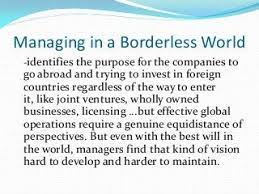Impacts of a Borderless Society. 2022 Best

This paper explores impacts of a Borderless Society. You now live in a world where geographic boundaries cease to exist when it comes to goods, services, and even food.
Impacts of a Borderless Society.
You now live in a world where geographic boundaries cease to exist when it comes to goods, services, and even food. Most people think nothing of having freshly squeezed Florida orange juice or New Zealand kiwis for breakfast; even those who live in New York City with 10-inches of snow on the ground in the middle of January. In this day and age, everything and anything is available for consumption year-round at a local grocery store if you have the financial means. Although it may be an “unintended consequence,” these conveniences can come with potentially major ecological and economic impacts that are both positive and negative.
Impacts of a Borderless Society.
For example, the coffee you drink may come from beans imported from Columbia, the sugar you use may come from India, or the steaks you sear on the grill may have come from Argentina. How much fuel was spent transporting these products across land and ocean? Were any pesticides used? If so, was it done in a sustainable fashion? Were forests cleared to make room for grazing herds or larger agricultural fields? These are just a few of the many questions that should be considered when making selections at the grocery store. For this Assignment, you will collect data about different food items.
Impacts of a Borderless Society.
You will then use the information you collected along with any research conducted, to reflect upon how food choices can impact both the environment and the economy. Go to a major grocery chain store in your area (or online) to research the following items: Salmon filet, – Kobe beef steak, truffle oil, – onions, potatoes, – avocados, bananas, – orange juice, cashews, – black tea, green tea, – coffee. Part 1: Data Collection A table is provided below for your use in order to help you organize the data that you will be collecting. Select two of the items from the shopping list and research the following: Where was the food item produced?
Impacts of a Borderless Society.
Approximately how far would the food item have to travel to get to your city/town? Would this be considered a local food based on the reading (Local foods are ones that are sourced from within 100 miles)? If the answer to number 3 was no, is there an alternative that you could use as a substitute that is local? List a minimum of four energy inputs that humans must provide to grow, package/prepare, and transport your food item from where it was produced to the store.
Part 2: Data Analysis Using the Internet, your textbook or the Purdue Global Library, conduct your own research to learn more about the variety of ways in which food can be acquired: Anderson, L. (2015). Most Americans Could Eat Locally, Research Shows.
Impacts of a Borderless Society.
Retrieved from https://news.ucmerced.edu/news/2015/most-americans-could-eat-locally-research-shows Jonathan, K. (2010). Eat Green: Our everyday food choices affect global warming and the environment. Retrieved from https://www.nrdc.org/sites/default/files/eatgreenfs_feb2010.pdf Think Global, Buy Local: A new study looks at the impact of buying local produce on local economies. (2014). Retrieved from http://foodtank.com/news/2014/04/think-global-buy-local-a-new-study-looks-at-the-impact-of-buying-local-prod Local & Regional Food Systems. (2015). Retrieved from http://www.sustainabletable.org/254/local-regional-food-systems.
Impacts of a Borderless Society.
Reflect on the data you collected as well as the research that you conducted as you answer the following questions: Discuss the impacts our food purchases may have on the environment and economy. Discuss two advantages to purchasing food items that are locally sourced versus those shipped from other areas of the country and from around the world. Discuss two disadvantages to purchasing food items that are locally sourced versus those shipped from other areas of the country and from around the world. Minimum Submission Expectations for Part I: Answers should be presented in the table provided in complete sentences except when specifically asked for a list. https://youtu.be/vzc9H_Wiytg
Impacts of a Borderless Society.
Font size 10 or 12. Free of grammar, spelling and punctuation errors. No evidence of plagiarism. Use the APA style for all citations. Minimum Submission Expectations for Part II: At least 300 words not counting the questions or reference pages. Answers should be double spaced, font size 10 or 12. Use a minimum of three sources (at least one from the PG Library). Free of grammar, spelling and punctuation errors. No evidence of plagiarism. Use the APA style for all citations. Be original and insightful with no more than 10% taken verbatim from any outside sources.
Additional Files







